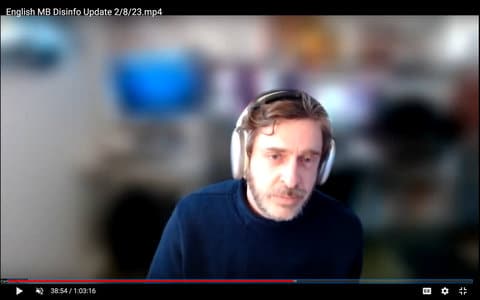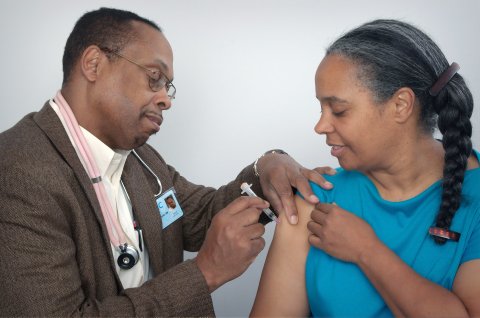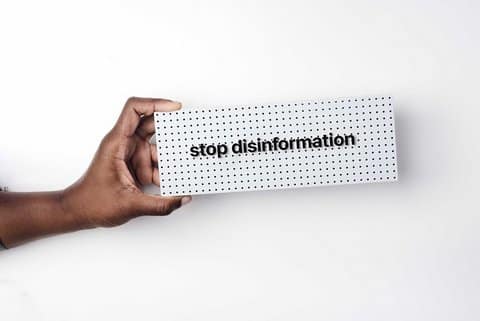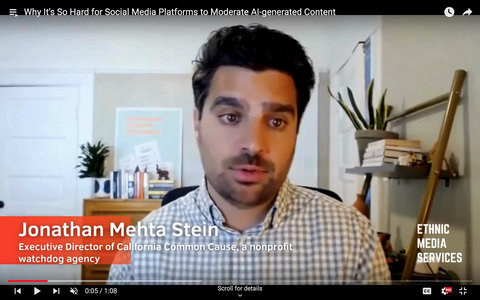
09 Mar Disinformation Spreads Like a Disease, Expert Says


Cameron Hickey of the National Conference on Citizenship gave a talk Feb. 8 for Ethnic Media Services on disinformation. (Screenshot captured by Danielle Parenteau-Decker / The CC Pulse)
By Danielle Parenteau-Decker
As disease has spread during the COVID-19 pandemic, so has disinformation. One expert says the two have a lot in common.
Cameron Hickey, CEO of the National Conference on Citizenship, spoke Feb. 8 about disinformation, how it spreads and the threat it poses during a news conference for Ethnic Media Services.
“Viral misinformation is contagious and dangerous,” he said. “It is, in some cases, as problematic as some of the actual viruses that are spreading in that it can instigate people to make very poor decisions that can put their health at risk.”
>>>Read: Visual Disinformation Can Be Especially Persuasive, Expert Warns
Disease comes in many forms and spreads in many ways. The same is true for disinformation.
“Rumors, lies and just misunderstandings spread in ways that are very similar to these viruses,” Hickey said. “They go from one person to another. They evolve and they mutate.”
According to Hickey, problematic content can come in the form of misinformation, rumors, conspiracies, disinformation, junk news and hate. Junk news is “not totally false but still not healthy for you, just like junk food.”
The terms “misinformation” and “disinformation” are sometimes used interchangeably because both refer to information that is partly or completely false. But according to Purdue University, there is a difference depending on intent. Misinformation is unintentionally presented as fact; disinformation is deliberately shared by someone who knows it is not true.
“While we care about the intent, for the purposes of trying to address the problem, it often becomes irrelevant,” Hickey said. “If people are misled, whether they were or were not done so intentionally can be beside the point.”
Hickey offered advice on what people could watch out for to recognize this problematic content. “There are a lot of clues to look at.” Among them, noticing if something makes you “feel scared, angry or self-righteous to get you to change your behavior,” he said.
“Some things actually are scary and we should be upset about them. But frequently, fear mongering is a tactic used to amplify mis- and disinformation,” he added.
>>>Read: I Faced Down Fear and Misinformation to Get Vaccinated
He said it is also important to take note of whether content references like “boogeymen: the ‘deep state,’ Bill Gates or George Soros,” are “lacking critical background details” or use logical fallacies or “terms or themes that divide based on identity.”
“Any time messages even allude to concepts that are about identity, that serve to divide, that play on stereotypes — even if it’s not overt hate speech — these kinds of messages are often problematic ones that lead to misunderstandings, misinformation,” Hickey said.
Another thing to keep in mind is whether what you’re seeing may be out of date or missing vital context. Even if something is not entirely untrue, it may not be what it seems.
“There may be information that is, on the surface, technically true but when shared without the proper context can be incredibly misleading,” Hickey said.
>>>Read: Vaccine Disinformation Preys on Black Community’s Well-Earned Distrust
Similarly, with faulty logic, arguments that “can’t be proven to be false aren’t necessarily exactly true either.”
False equivalency, for example, is “when you are comparing things and making the implication that if this is true, then this should also be true because they’re similar,” Hickey said. “But when they aren’t actually similar, when you’re comparing apples to oranges, then the underlying argument is no longer valid.”
Hickey said there are themes that come up frequently in health disinformation. These include blaming high-profile deaths or death in general on the COVID-19 vaccine with no basis.
“There is data showing that higher than average number of people dying compared to moments in the past,” he said. “This factual information is being re-contextualized to suggest that those increases in deaths are the result of COVID-19 vaccines. There is no evidence to link those two things together, and there is evidence connecting many other reasons for increases in deaths.”
Among those reasons might be that many people have forgone or delayed healthcare during the pandemic, meaning a lot of illness went undiagnosed and untreated, and “that lack of treatment is coming back to hurt us,” he said.
>>>Read: Mistrust and Misinformation Hold Back Black Vaccination Rates
“We’re never going to stop these myths. If it’s not a myth about COVID-19, it’s a myth about something else,” Hickey said. “The appetite for this stuff does not go away,” nor do the incentives to spread it, whether political, financial or “just to stir the pot and make people crazy.”
While the spread of disinformation cannot be stopped, the effect it has can be reduced.
“We should look at what’s good, and what’s good is here in the United States … The vast majority of people have gotten a shot,” Hickey said he heard someone say.
Hickey continued, “Whether or not the people that got the shot continued to believe in these myths or whether or not we’ve gotten a handle on the myths, the vast majority of people have gotten at least one shot despite all that has happened.”
Further information about the COVID-19 vaccine is available online from Contra Costa Health Services at coronavirus.cchealth.org/get-vaccinated.






No Comments